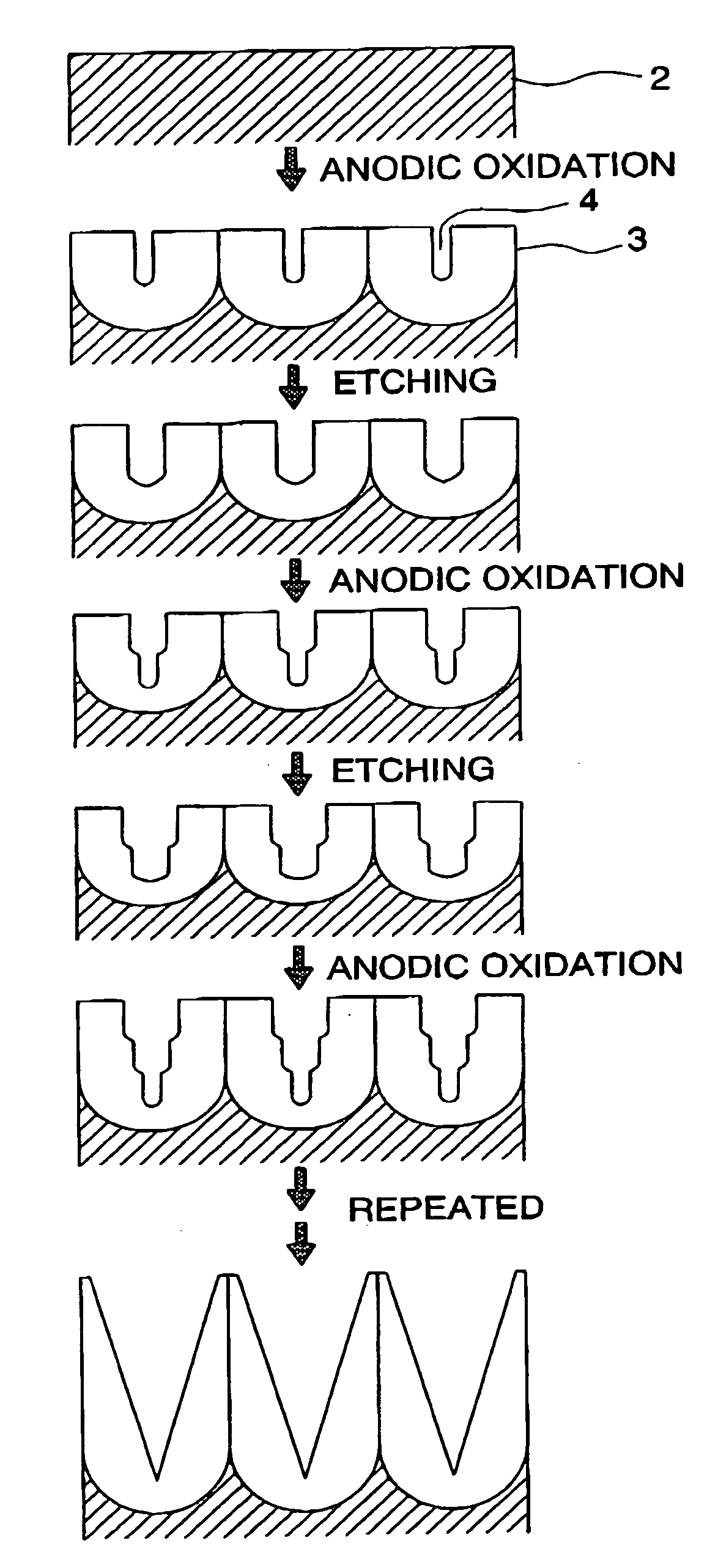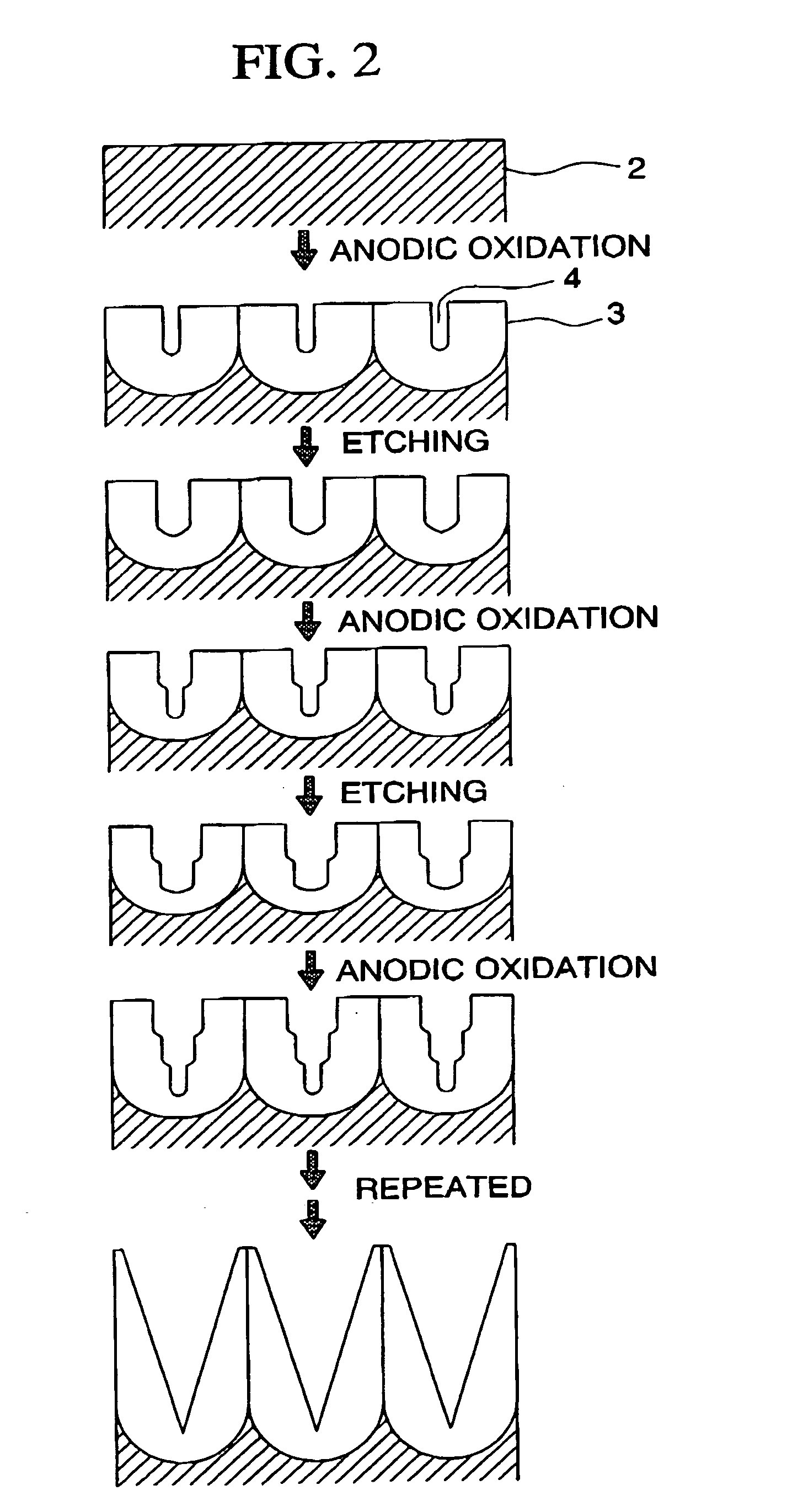Anti-reflective film and production method thereof, and stamper for producing anti-reflective film and production method thereof
a technology of anti-reflective film and stamper, which is applied in the direction of printing, reproduction, printing, etc., can solve the problems of difficult to produce inexpensive stampers, difficult to control the taper shape, and difficult to form the optimum tapered shape required for the formation of a non-reflective layer, so as to reduce reflection
- Summary
- Abstract
- Description
- Claims
- Application Information
AI Technical Summary
Benefits of technology
Problems solved by technology
Method used
Image
Examples
example 1
[0044]Anodic oxidation was carried out on an aluminum sheet of 99.990% purity for 50 seconds at a temperature of an electrolyte of 17° C., formation voltage of 40 V, and using 0.3 M oxalic acid for the electrolyte. Subsequently, pore diameter enlargement treatment was carried out by immersing for 5 minutes in 2% by weight phosphoric acid at 30° C. This procedure was repeated five times to obtain anodic oxidized porous alumina having tapered pores having a period of 100 nm, pore diameter opening of 80 nm, bottom of 25 nm, and pore depth of 300 nm.
[0045]After filling the pores with methyl methacrylate monomer containing benzoyl peroxide of 5% by weight as a polymerization initiator, the monomer was polymerized by irradiating with ultraviolet light. Following polymerization, the polymer layer was separated from the mold to obtain polymethyl methacrylate resin having an arrangement of projections on the surface thereof. As a result of measuring the reflectance of the resulting polymer f...
example 2
[0046]Anodic oxidation was carried out on an aluminum sheet similar to that of Example 1 for 6 seconds at a temperature of an electrolyte of 17° C., formation voltage of 25 V and using 0.3 M sulfuric acid for the electrolyte. Subsequently, pore diameter enlargement treatment was carried out by immersing for 3 minutes in 10% by weight phosphoric acid at 30° C. After repeating this procedure five times, anodic oxidation was carried out for an additional 6 seconds to obtain anodic oxidized porous alumina having tapered pores having a period of 63 nm, pore diameter opening of 55 nm, bottom of 20 nm, and pore depth of 170 nm. Subsequently, reflectance was confirmed to have decreased as a result of trusferring the structure to a polymethyl metbacrylate resin in the same manner as Example 1.
example 3
[0047]After carrying out anodic oxidation on an aluminum sheet in the same manner as Example 1 for 2 hours at a temperature of an electrolyte of 17° C., formation voltage of 40 V and using 0.3 M oxalic acid for the electrolyte, the porous alumina layer was selectively dissolved and removed by a mixed solution of phosphoric acid and chromic acid. Subsequently, anodic oxidation and pore diameter enlargement treatment were repeated under the same conditions as Example 1 to obtain anodic oxidized porous alumina having tapered pores in which the pores were arranged with high regularity. Subsequently, reflectance was confirmed to have decreased as a result of tansferring the structure to a polymethyl methacrylate resin using the same procedure as Example 1.
PUM
| Property | Measurement | Unit |
|---|---|---|
| pore depth | aaaaa | aaaaa |
| pore depth | aaaaa | aaaaa |
| formation voltage | aaaaa | aaaaa |
Abstract
Description
Claims
Application Information
 Login to View More
Login to View More - R&D
- Intellectual Property
- Life Sciences
- Materials
- Tech Scout
- Unparalleled Data Quality
- Higher Quality Content
- 60% Fewer Hallucinations
Browse by: Latest US Patents, China's latest patents, Technical Efficacy Thesaurus, Application Domain, Technology Topic, Popular Technical Reports.
© 2025 PatSnap. All rights reserved.Legal|Privacy policy|Modern Slavery Act Transparency Statement|Sitemap|About US| Contact US: help@patsnap.com



